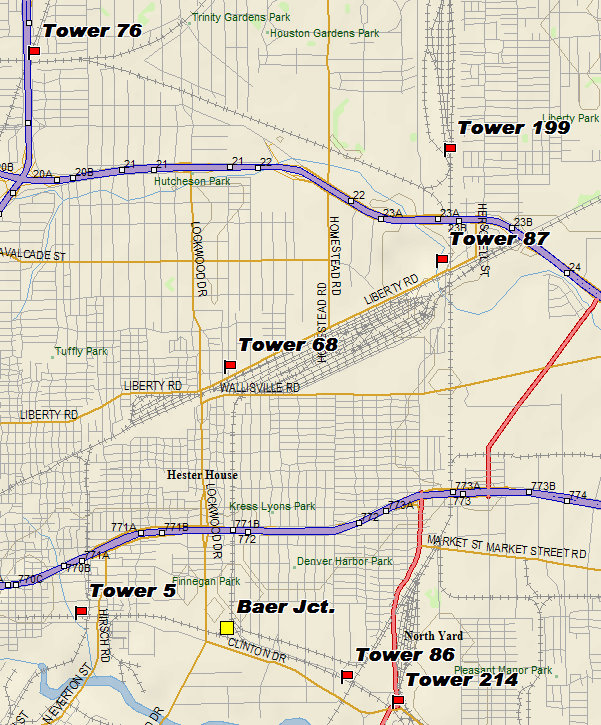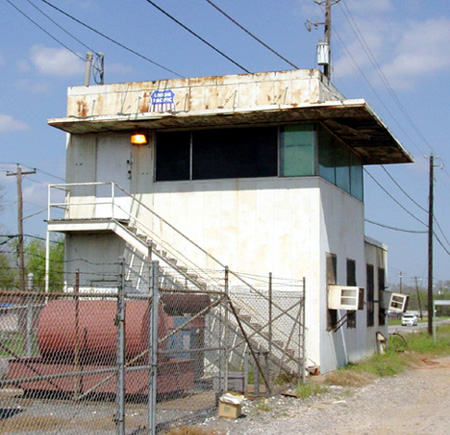
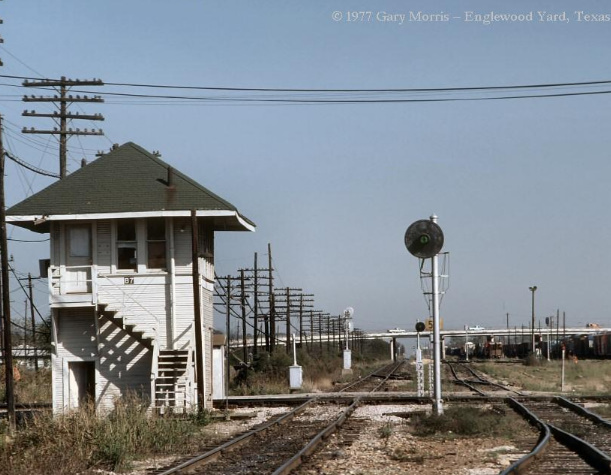
Texas Railroad History - Tower 68 and Tower 87 - Houston (Englewood Yard)
Two Towers at Southern Pacific's Englewood Yard
Tower 68 (Daniel Walford photo)
Tower 87 (Gary Morris photo)


Southern Pacific (SP) expanded its presence in Texas during the late 1800s
by acquiring control or full ownership of several railroads. As it expanded, SP recognized the
advantages of consolidating its switching and maintenance operations as much as
possible. It's first major yard in the Houston area was at Hardy Street, north
of Buffalo Bayou. Early on, Hardy Street Yard was the effective terminus for two
of SP's railroads: the Houston & Texas Central to the north and the Texas & New
Orleans (T&NO) to the east. In 1888, SP moved the yard operations for another
railroad, the Galveston, Harrisburg & San Antonio (GH&SA) Railway, to Hardy
Street from Harrisburg, retaining the facilities at Harrisburg for industry
operations along Buffalo Bayou. Even by this early date, the signs were becoming
clear -- Houston, not Harrisburg or Galveston, would eventually become the major
population center for the Texas Gulf Coast.
The T&NO main line east to Beaumont and points beyond passed through open
land northeast of downtown Houston. In 1895, SP built a new yard there,
Englewood Yard, approximately three miles east of Hardy Street Yard. Over time,
operations were sorted out between the yards; Englewood took on greater
switching duties while Hardy Street took on more maintenance work. The opening
of Englewood Yard motivated the need for shorter connections to the industries
located along Buffalo Bayou. A short distance south of Englewood, SP already
owned tracks along the north bank of Buffalo Bayou that had been built in 1876
by the Texas Transportation Co. In 1896, T&NO built a connection between
Englewood Yard and Magers, paralleling the existing
tracks for approximately one mile west from Magers before turning due north (at
a location known as Baer Junction) to reach the west end of Englewood Yard.
Given the layout of Englewood Yard, this routing had the benefit of allowing
movements between Hardy Street and tracks serving Buffalo Bayou without having
to traverse Englewood Yard.
In 1907, an interlocker was installed at the location where the line from
Baer Junction reached the T&NO main line at the west end of Englewood Yard.
Arguably, Tower 68 was the first "yard tower" in Texas to receive an
interlocker authorized and designated by the Railroad Commission of Texas (RCT).
In its initial listing in the RCT annual reports (1907), the only railroad
listed as involved
in the crossing is "GH&SA Yards". Obviously, since Englewood was built along the T&NO main line,
Tower 68 could presumably have been listed by RCT as a T&NO tower, and in later
annual reports, RCT eventually listed this interlocker as supporting "GH&SA
Yards, T&NO".
At the east end of Englewood Yard, Tower 87 was opened in 1911 to control a different
junction and provide additional yard tower services. The Tower 87 interlocker
controlled a crossing of the T&NO that had existed since 1907 when the Houston,
Belt & Terminal (HB&T) completed 8 miles of new track between
Tower 86 and Tower 80,
part of the Belt Line around northeast Houston. HB&T apparently decided to
interlock several crossings to improve operational efficiency, hence four
consecutive towers: Tower 84,
Tower 85, Tower 86 and Tower 87 all involved the HB&T.
It is interesting to note
that RCT listed Tower 68 as located at "Englewood (Houston)" and Tower 87
as located at "Houston (Englewood)". Tower 87 was
removed in 1982. Tower 68 stood until the summer of 2010, per this email
from Tom Kline dated 10 August 2010:
"Just a short
note to let you know the former SP Tower 68 at
With the UP/SP merger, UP controls both Englewood Yard and Settegast Yard, which is located a short distance north of Tower 87.
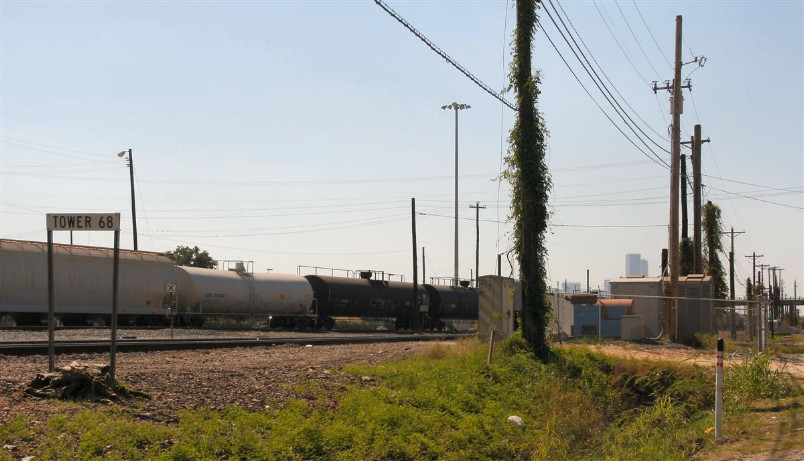
Above: Mark St. Aubin took this photo of the site
of Tower 68 in the summer of 2010. The sign remains, but the tower, which sat
along this side of the fence at right, is gone. The tan dirt and sand at lower
right marks the precise location.
Below: Tower 68 (photo
by Bill Hale, courtesy of Art Fisher). Given the concrete construction
of the tower and the numerous changes at Englewood since 1907, it is perhaps
likely that the
current tower replaced an earlier structure.
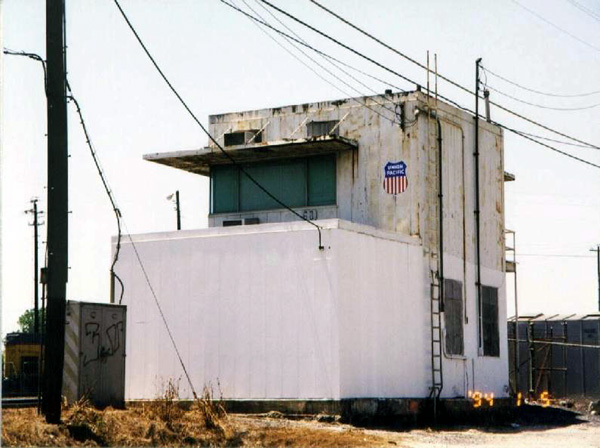
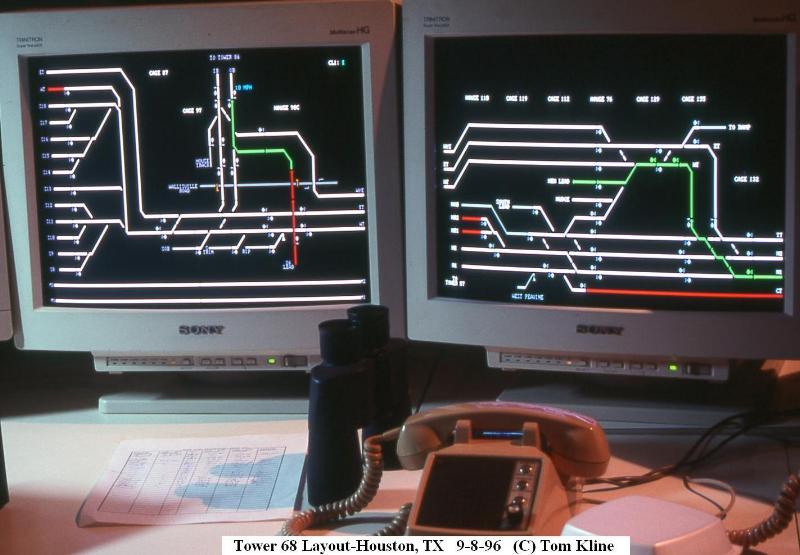
Above: Digital display
in Tower 68 (Tom Kline photo)
Below: Undated Tower 68 interior photo (courtesy Greg Johnson)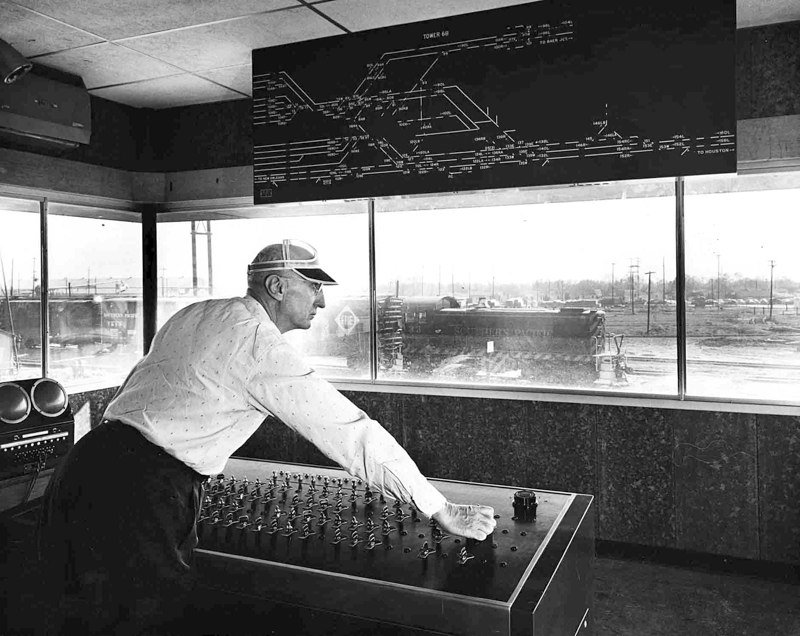
Below: The GH&SA line from the south still enters Englewood Yard at Tower
68, although the yard has many more
tracks than it did originally. The tower was
located.............HERE!.........at the top center edge of the image.
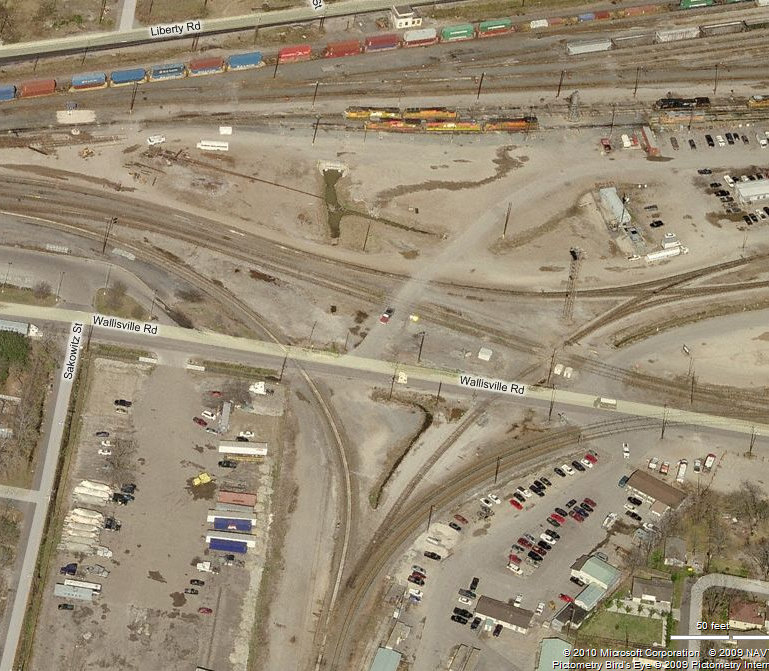

Above: Facing west passing Tower 87
eastbound sometime in the late 1930s, railroad magnate John W. Barriger III took
this photo from the rear of his business car.
(John W. Barriger III National Railroad Library)
Below: An H&BT
train passes Tower 87 in 1955. The tower was located north of the SP tracks and
south of Liberty Rd. on the west side of the HB&T line. (Dean Hale photo,
courtesy Temple Railroad & Heritage Museum)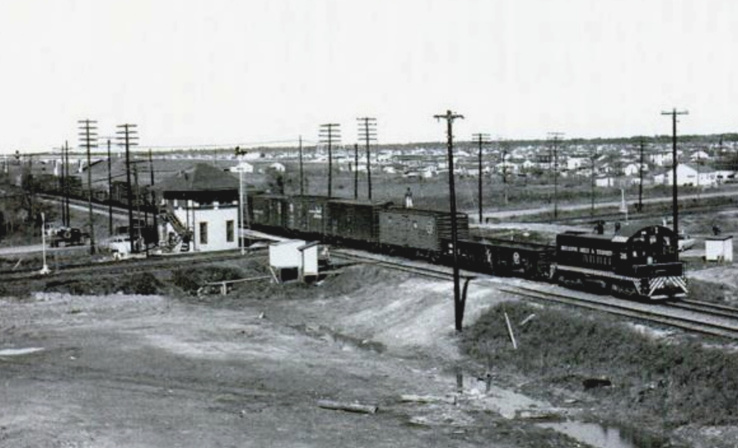
Below: Facing west, this bird's eye view shows that the original site of
Tower 87 is now in the shadow of Wayside Drive.
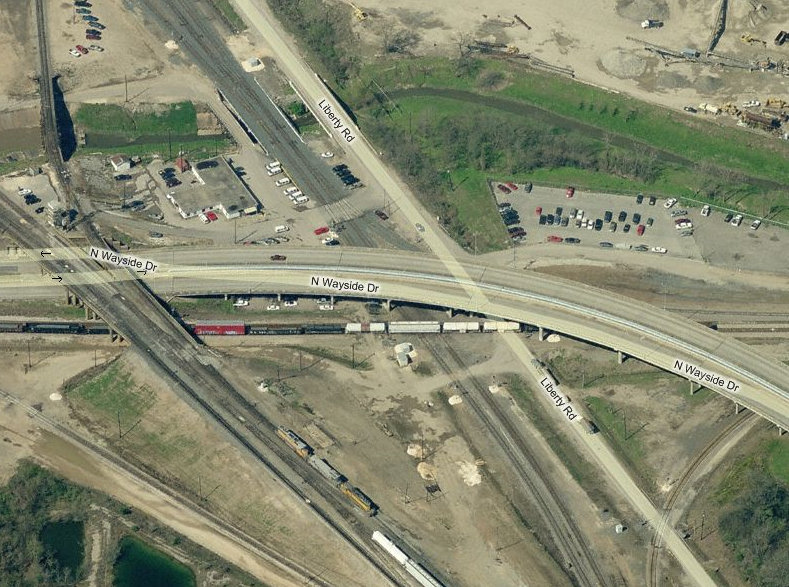
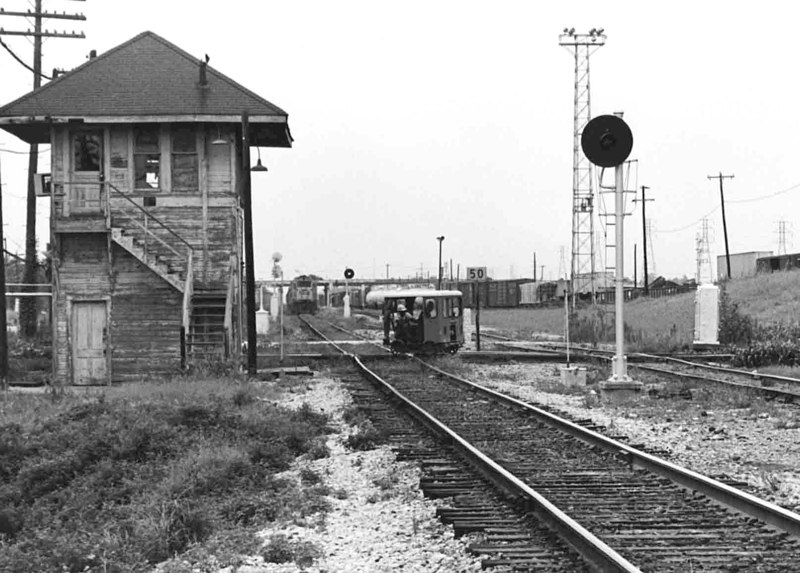
Above: Tower 87 in 1984 (courtesy Greg Johnson)
Above:
Stuart Schroeder supplies this photo and adds.."I
worked at Tower 87 at Englewood late 1981 and early 1982 until the tower was
demolished when the second main track was constructed between Englewood and
Dawes on the Lafayette Sub. My photo is from early 1982 just prior to the
demolition of the tower."
We do not know the precise date for the razing of Tower 87, but Stuart's 1982 photo "just prior to the demolition of the tower" could conflict with the 1984 date on Greg Johnon's photo. Stuart explains..."I believe the Greg Johnson photo was taken several years earlier. The second main track was already in service by April/May, 1982 when I was working the SP RTC job at Union Station. ... As best I recall Tower 87 was razed by mid-82. We moved into a nearby GELCO trailer with the temporary controls in early 1982 and then the control center was transferred to HB&T Union Station to be with the HB&T RTC operator. This was the very first attempt at a joint rail traffic control center for the Houston area. The second main track was laid where the tower once stood." However, Greg's photo appears to show the tower in considerably worse shape than Stuart's photo, perhaps even abandoned (or maybe it just needed a paint job!)
Below: Stuart's track chart from his notebook in
mid-1981 when he was training at Tower 87
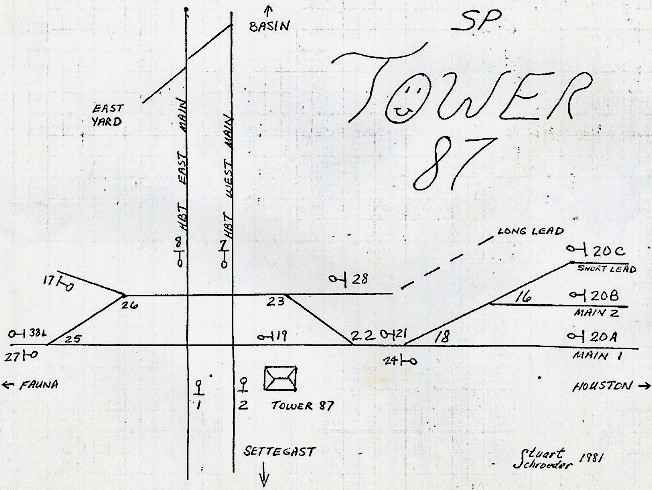
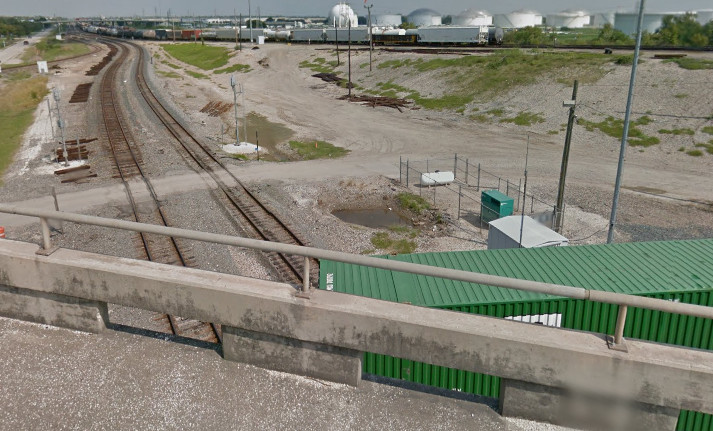

Above: A cabin replaced the tower, but still says "Tower 87" (Google Street
View, Sept. 2015, from Wayside Drive)
Location Map, Towers 68 and 87
